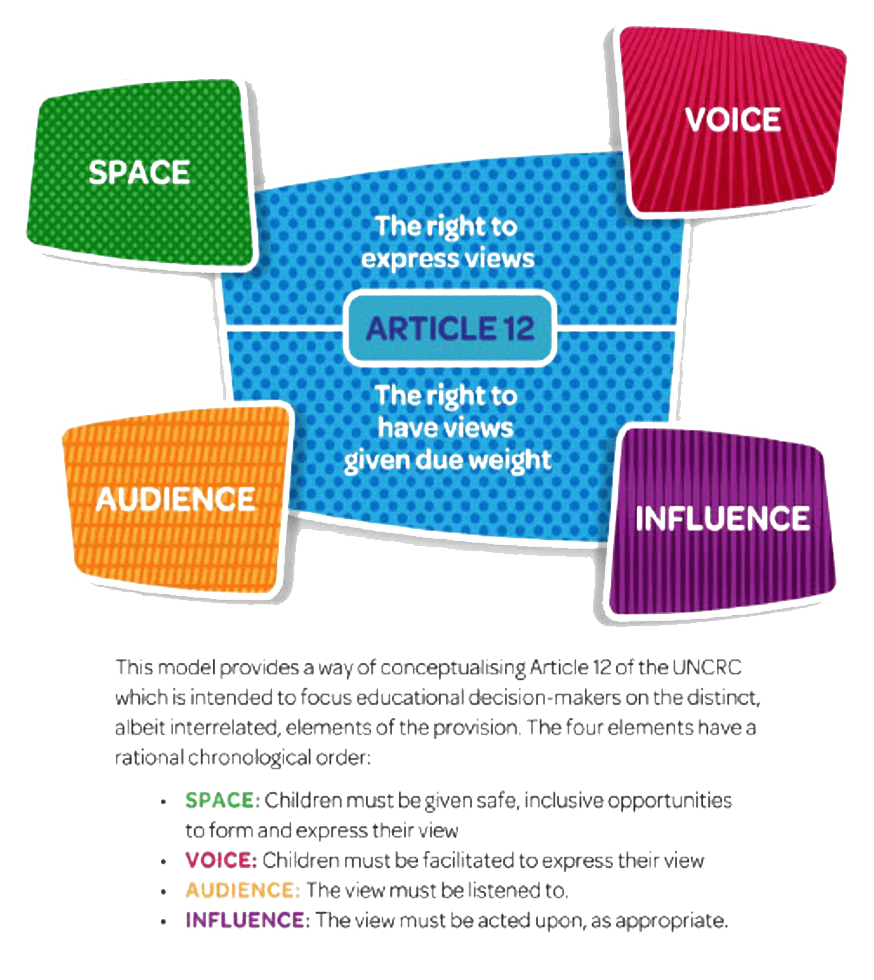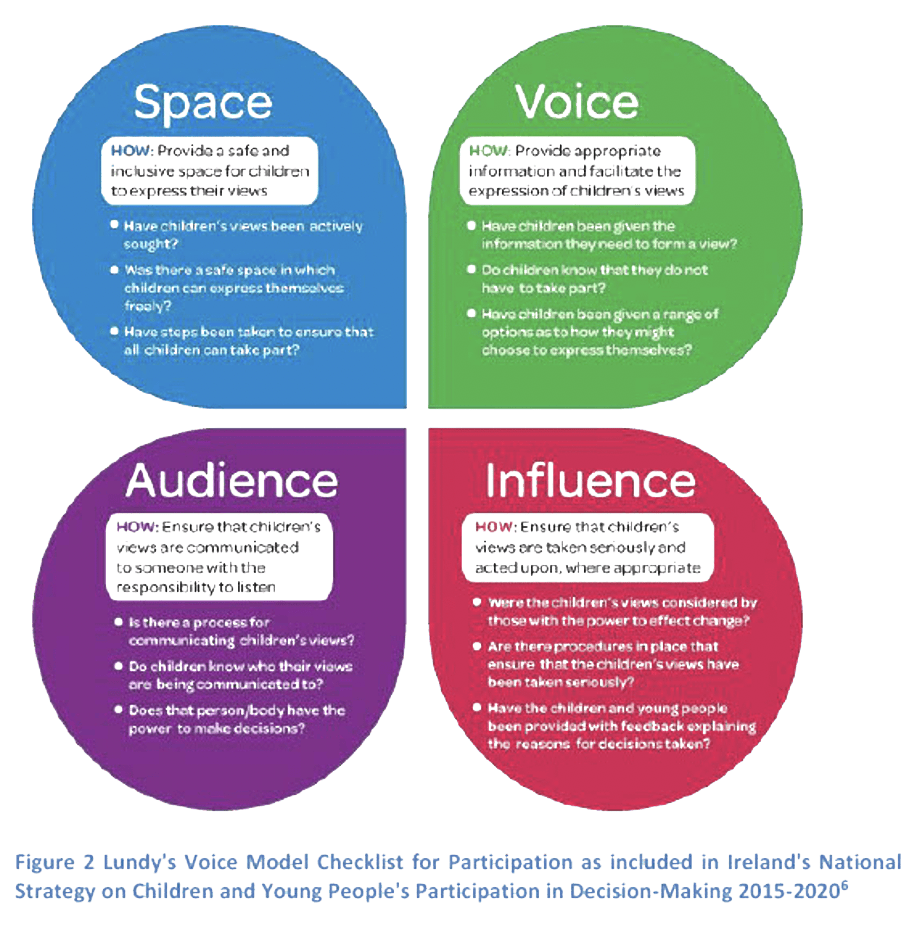There are many best practice models available, and your organisation may have one it prefers. VoF has researched and recommend the following as best practice models when engaging with families.
The Lundy model is a child engagement tool however we have used the concepts to create question examples for family engagement.
1. Voice of Parents: A Model for Inclusion:
The Voice of Parents (VoP): Model for Inclusion is led by the Centre for Excellence in Child and Family Welfare. The project aim was to develop an evidence and lived experience informed systemic approach to parental participation and seeks to facilitate guidance in effective engagement of parents in contact with child protection with child and family services.
The project stated: The Voice of Parents project will develop a framework for parent voices to be heard through a Charter of Parental Participation, agreed principles that can be applied across organisations and programs in the child and family services sector, and a Parent Participation Model (with a practical tool kit of resources). These resources will be used by government and the child and family services sector across Victoria for the inclusion of parents’ voice in their work.
The project was completed and launched in August 2022 and provides excellent resources including project publications, videos and relevant articles which are available online at the Centre for Excellence in Child and Family Welfare. https://www.cfecfw.asn.au/voice-of-parents/
The VoP ethical participatory framework contains six key principles to guide development of project strategies:
- Recognition of expertise: Participants should be recognised as experts of lived experience, both in system navigation, in their own lives, and, if engaging parents, in their children’s lives.
- Remuneration: A non-negotiable participant financial contribution recognising the expertise of lived experience.
- Mechanisms for sharing power: To minimise the impact of inherent power dynamics, engagement opportunities have in built mechanisms that enable sharing power and elevating lived experience voices where possible.
- Clarity of privacy and disclosures: Provide clear parameters on the collection, storing, use and sharing of participant information. This may relate confidential and what will be used during the project. Reiterate participant choice including their ability to opt out. Make sure they are aware of any reporting obligations that could be trigger a mandatory disclosure (e.g., a child in danger) through discussions.
- Accessible information: Provide project materials and resources in a variety of ways to ensure sharing of information is timely, engaging and fit of purpose. Remember that not everyone will have the same levels of literacy and access to IT.
- Trauma-informed: Above all, engagement needs to be trauma-informed, particularly when exploring sensitive topics such as those relating to Child Protection. Projects should have a range of options to mitigate or support any distressing impacts of participating.
Key Principles of Ethical Participation. Voice of Parents: Model for Inclusion June 2022

The work we do (our technical expertise) in early years services is no more important than how we do it (our relational expertise). If practitioners want to make their services accessible to families who view services with suspicion, a useful starting point is to examine why families feel that way; traditional service perceptions of parents; what barriers parents encounter in accessing services; and the type of relationships necessary to sustain the engagement of parents. (Prichard et al)
2. Family Participation Model:
The Family Participation Model (FPM) was devised in the UK in the 1980s by Hilton Davis and his colleagues at the Centre for Parent and Child Support (Davis et al, 2002; Davis & Rushton, 1991). It is an evidence-based approach to working with families that involves:
- building parents’ capacity to utilise their own resources and establish methods for adapting to and managing problems in the long-term;
- engaging parents and developing a relationship with them that is supportive in and of itself; and
- understanding families in a holistic way, “hearing the whole story, seeing the full picture, knowing their main worries, learning their strengths” (Davis et al).
The model is based on the central belief that the helping process is most successful and effective when people actively work together for a common purpose, making the best use of their shared knowledge and expertise. This aligns with a key priority in the C4C Bendigo 2022-2026 Community Strategic Plan – Families have Agency.
An example of incorporating the FPM into an Australian organisation and service, is the Tasmanian Child and Family Centres (CFC’s), which aim to improve the health and well-being, education and care of Tasmania’s very young children by supporting parents and enhancing accessibility of services in the local community. The CFCs used the FPM as an evidence-based approach to working with families which played a central role in the inception, design, planning and delivery of 12 integrated CFCs in Tasmania. (Prichard et al).
In the process of establishing the Tasmanian community-based CFCs, .
- Community engagement should be an integral part of any community-wide initiative that seeks to improve outcomes for families with young children.
- Every community has strengths –start with the good news.
- Don’t assume that nothing is happening in marginalised communities.
- The history of the community matters.
- To engage marginalised communities, you need to do engagement differently.
- Symbols of power matter.
- Easier said than done.
- Relationships are important at every level.
- When working to develop a community initiative, all the principles that are used in a FPM approach are important.
- Language can alienate people.
- Communities exist within broader socio-political structures.
- Flexibility and preparedness for change is required by everyone involved in the process of engagement and empowerment.
- Engagement is an ongoing process.
3. Lundy Model of Child Participation
The Lundy model of child participation was established in 2014 at Queen’s University Belfast as a practical conceptualisation of Article 12 of the UN Convention on the Rights of the Child (CRC) – the legislation that requires governments to ensure that children’s rights are respected. This model suggests that implementation of Article 12 requires consideration of four interrelated concepts: space, voice, audience and influence.

Since 2014, the Lundy model of child participation, based on four key concepts (Space, Voice, Audience and Influence), has been used and adopted by national and international organisations, agencies and governments to inform their understanding of children’s participation, generating a sea-change in global understanding of child rights-based participation for both policy and practice.
The Model



